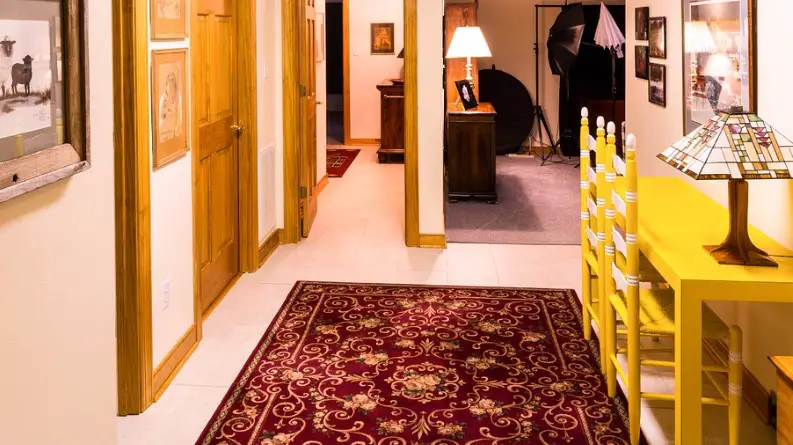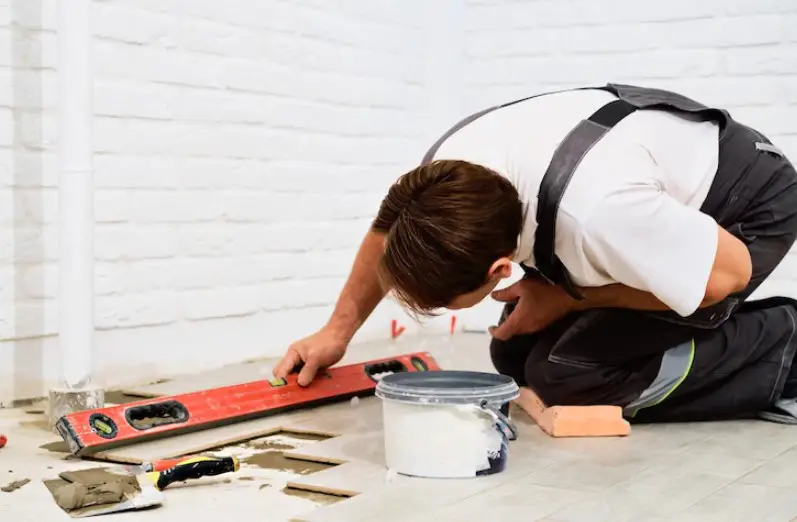Last Updated on July 10, 2023 By Emma W. Thomas
When gluing carpet tiles to plywood, there are several adhesive options available. Pressure-sensitive adhesive (PSA) is commonly used for this purpose. Another option is adhesive spray, which offers ease of application and good adhesion. Additionally, some carpet tiles come with peel-and-stick backing, eliminating the need for additional adhesives. It’s essential to choose an adhesive that is suitable for both the carpet tile material and the plywood surface.
This article highlights the primary factors, best adhesives, and steps to follow when installing carpet tiles. Read on!
What should you consider when choosing carpet adhesives?

Before picking on a particular glue, knowing that not all will work for your project is necessary. The following factors are worth considering;
The kind of floor
The type of floor to which you want to glue the carpet tiles plays a significant role in choosing an adhesive. Some glues are suitable for concrete, vinyl, or hardwood. Before purchasing the product, be sure to check the specifications to get the right one for your job.
Whether solvent/water-based
When selecting an adhesive for your carpet tiles, it is essential to know whether you want solvent or water-based. While solvent-based glues will last longer, they may release toxic gases before curing. On the other hand, water-based adhesives may not last long, but they do not emit harmful gases and are environment-friendly and safe for health.
If you are looking for an adhesive for long-term projects, solvent-based glue is the go-to product. These substances will also hold up properly against the chemicals found in cleaning supplies. You can also use the product in high-traffic areas of your house though you will have to cope with the off-gassing before the substance dries up completely.
You may also opt for low-solvent content glues since they don’t produce as many gases as the high-solvent-content ones. While such products may not be very durable, they will last longer than their water-based counterparts.
The purpose of the carpet tiles
Your aim of installing carpet tiles is also crucial when picking the suitable Adhesive. For instance, installing carpet tiles outdoors is different from applying one in the living room. A low-traffic area will also differ from a high-traffic one since the latter needs a more durable glue than the former.
Your room’s moisture content
The moisture content of the room where you are installing the carpet tiles will also impact the type of Adhesive to buy. For example, a room with high moisture needs glue that will hold up well and a water-resistant one. In this case, going for a marine-based adhesive will be advantageous.
The Adhesive’s working /open time
It is also vital to know the glue’s open and working time before picking on any. Open time refers to the maximum time you can wait before putting the carpet tile after applying the Adhesive. Conversely, working time is when you can change the position of the carpet tiles after the installation process.
If you are doing this job for the first time, you may need an adhesive with a higher working time to allow for trial and error. Be sure to check the label for these crucial requirements.
Which are the best adhesives for gluing carpet tiles to plywood?

Having known the factors to consider when picking the proper adhesives to glue carpet tiles on your plywood, here is a list of adhesives that we came up with;
Roberts 6300
This type of Adhesive is excellent for indoor use, sensitive to pressure, and easy to use. You can easily reposition the carpet tile if you make a mistake since it only bonds upon applying pressure. The glue is also excellent to use in a room with high moisture content as it has a dampness control of up to 10 pounds.
Henry 356 carpet adhesive
Henry 356 carpet adhesive is resistant to moisture and low temperature. Due to its low chemical content, Henry 356 adhesive is excellent for indoor use as it gives off minimal fumes and odor. You can also perform trial and error with your carpet tile since it provides excellent work/open times.
DAP Weldwood
DAP Weldwood is a floor tile glue that is water-resistant and latex-based. This product is easy to reposition and spreads appropriately. It is also excellent for indoor use as it produces minimal amounts of gas and odor. If you want to use an environment-friendly product, look no further than DAP Weldwood.
3M Hi-Strength 90
3M Hi-strength 90 is an adhesive spray that provides a permanent bond with little production of toxic fumes. You can use this glue in construction or small projects since it is health-safe and echo-friendly. This Adhesive is resistant to temperature and moisture but not suitable for repositioning due to its fast-drying formula and low working time.
Titebond adhesive
Titebond is a carpet and tile water-based glue that is suitable for use with indoor and outdoor projects. Since the product is water-based, it does not give off toxic gases or smells. You can use this Adhesive for any carpet needs due to its professional-grade strength.
Sugarman creations
Sugarman Creations is a sturdy carpet glue that gives a durable hold suitable for high-traffic areas. This product has a money-back guarantee, and it’s ideal for use by professional carpet layers.
RecPro
This Adhesive is a floor glue that is strong, water-based, and marine-grade. You can apply it on various surfaces, including RVs and boats. But, the Adhesive may be unsuitable for aluminum and fiberglass. You can easily apply the glue using a paint roller.
Duct tape adhesive
Duct tape is an excellent indoor and outdoor carpet glue. The product is not messy like other glues and is easy to use. It is excellent for use in outdoor and high moisture places due to its water-resistant qualities. Duct tape sticks to smooth and rough areas so well and is excellent for various projects.
This Adhesive is strong and bonds permanently since it melts on heating and is thus ideal for every weather condition.
Learn more: Should You Vacuum After Carpet Cleaning?
Steps to install carpet tiles

Carpet tiles are affordable, trendy, and a low-maintenance flooring option. Their installation is also easy and can be done by DIY enthusiasts with the proper knowledge of how to apply them. Below are some steps on how to install carpet tiles;
Step 1. Measure the room’s dimensions
The standard carpet tiles are squares, usually between 18 inches or 24 inches and the number you use depends on the area you are willing to cover. It is necessary to measure the room’s area and then divide it by the area of each square (carpet tile). You can add a few tiles for future repair or replacement in case some break while working with them.
Preparation of the area to apply carpet tiles
Preparing the room to install your carpet tiles is necessary to get the best outcome. Begin by removing all furniture pieces, if any, followed by any old flooring. But, if the floor is flat and smooth, like hardwood, ceramic tile, or vinyl, you can install the carpet tiles directly. When applying carpet tiles on an old flooring, it is advisable to be careful since the Adhesive may not bond well to the material.
If your floor has gaps and cracks, it is recommended that you fix them before the installation process begins. You can use a concrete patch to seal any chips or cracks on the concrete subfloor. Doing this helps to eliminate any unevenness on the floor and prevent any liquid spillage from penetrating through the tiles.
Cleaning the surface
You need to ensure that the floor is spotless after preparation to eliminate debris, dust particles, and any dirt. Dong, this will ensure that the adhesives form proper bonding. You can start by vacuuming or sweeping the entire place as many times as possible. You will then use a sponge or mop and warm water to clean the floor again. Ensure that the floor is free from moisture or liquid before applying the carpet tiles.
Sealing the subfloor
Use a suitable sealer to cover the subfloor before installing the carpet tiles to prevent the growth of mildew and mold. You can use an aerosol can, water bottle, metal tray, or paint roller to spray the concrete sealer.
Installing the carpet tiles
Once you are sure that the space is even, clean, and dry, you can fix the tiles using a suitable adhesive. You can begin from the middle of the room as you move towards the walls. Make sure to follow the guidelines or use your creativity to develop the most stylish floor you desire.
Wrapping up
Several adhesives exist for gluing carpet tiles to plywood and other types of flooring. What you choose depends on various factors to ensure that you get the best outcome. It will help if you read the label for specifications before picking on what suits your need.
References:
Emma is a graduate of Domestic Science or Family and Consumer Sciences (Home Economics) from the University of Wisconsin. She has 7 years of experience Working with the strategic section of BestBuy and now writing full-time for Homeeon.
From Managing the Home, Interiors, Cleaning, and Exteriors to Gardening and everything about Making A Home Liveable – is her passion and this Homeeon is the result of this.
Emma loves decorating her home with the best stuff found online. She cares about quality over anything and writes reviews about them here in Homeeon. Get in touch with her over Pinterest.
Keep reading her blogs.

